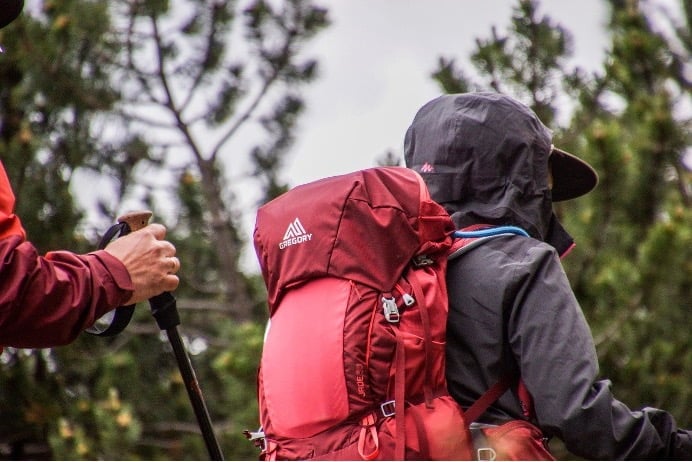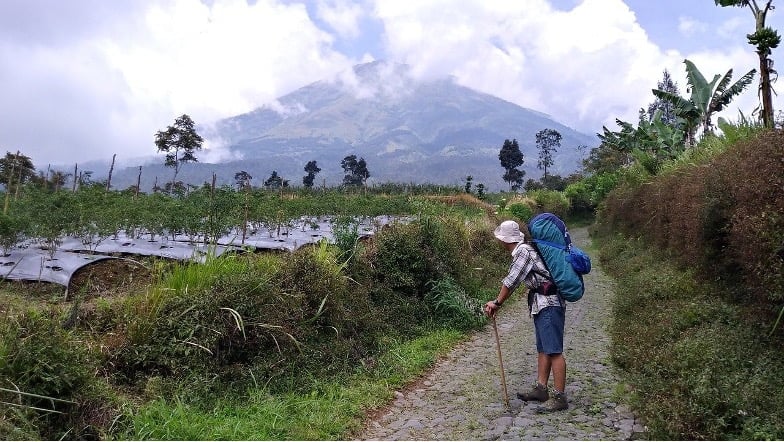The beautiful outdoors is always a great way to spend time enjoying some fresh air. Hiking is a great excuse to exercise and stretch those legs after a long week of working. Today, let’s discuss the best outfits to wear hiking, what to pack in your backpack, and what kind of shoes are the most practical for your adventure.
Some of the first factors to consider when going hiking is the weather, length of the hike, and your ideal comfortability. Let’s go through the best clothing options for general hiking activities, as well as various outdoor conditions where you’ll need to be more prepared.
Best Hiking Clothes and Items to Consider:
- Hats
- Shirt
- Jacket
- Shorts
- Pants
- Socks
- Boots
- Water Bottle
- Backpack / Fanny Pack
Hat Suggestions:
To start, let’s go through some hat options in case you’re taking a hike where it will be super sunny. A brimmed hat is always smart to bring along. Even if you don’t end up using the hat, it’s a super lightweight item to take with you and is easily attachable to any article of clothing, fanny pack, or backpack.
Hats with a cap are optimal for keeping the sun out of your eyes and can save you from suffering any harsh sunburn. Caps (bucket hats are a type of hat to consider wearing as well) also keep your head and hair dry if you’re traveling through the rain. Especially if you’re in a relatively cool climate, staying dry is very important! Walking around with wet hair in cold air could ultimately cause a cold or accelerate your lack of warmth on your hike.
Check out our top pick for a hiking bucket hat here and a brimmed hat here!
Shirt Suggestions:
Depending on the area that you’re hiking in, you may need to layer your clothing to stay warm enough. Layering is a great strategy for hiking fans because you’re able to add and remove layers as your outdoor conditions change. Keep in mind that your body is constantly moving on hikes, so you’ll want to pick the most comfortable tank tops, t-shirts, and long sleeves you can find. Softer materials allow your body to move more freely, giving you easier mobility when you hit more treacherous parts of your journey.
There are plenty of athletic clothing brands to choose from when deciding what tank tops, shirts, and long sleeves to layer. Just be sure to find clothing that will help regulate your body temperature properly and is durable. Some of the best materials to wear are polyester, nylon, and merino wool. These fabrics dry fast if you’re sweating and help move sweat off of the skin, making them the ultimate materials for layering (tees, sports bras, briefs, underwear, long sleeves, leggings, socks, etc.).
Here is a great hiking long sleeve for women and our favorite one for men!
Jacket Suggestions:
Assess the weather conditions you’ll be encountering on your hike and then decide what kind of jacket is the most suitable for you. There is plenty of rain jacket and fleece jacket options out there for colder and/or rainier weather. If you’re in warmer weather but want to play it safe, then consider bringing a windbreaker jacket. Windbreakers are extremely lightweight and can be very helpful if you start to experience high winds. These kinds of jackets are not made to insulate heat for your body, but instead, help resist wind from hitting you as you’re walking.
If you’re going to be running into rain or light showers, be sure to find a jacket that is water-resistant or completely waterproof. It’s important to get one with a hood as well. Wearing a hat is great for keeping your head dry but a hood gives you extra security.

Colder weather requires a thicker kind of jacket. The polyester fleece coats are your best option if you’re in any sort of wind and colder temperatures. Remember, once you’re out on your hike, you only have what you packed. It’s smarter to have a jacket than to leave one behind in case you encounter worse weather than you anticipated.
Take a look at this top-rated hiking waterproof jacket for women and this best seller for men!
Pant Suggestions:
Evaluate what kind of weather and terrain you’re about to experience before deciding what kind of shorts or pants to wear on your hike. You may need to protect your legs from the brush, thorns, tree limbs, or poisonous plants. In this case, pants would definitely be a better option. There are plenty of hiking pants options, but some people prefer leggings. Leggings are great for easy mobility and flexibility, however, you still need to be thinking about the type of terrain you’re walking through. That kind of fabric can easily be tarnished and ripped by these conditions, so be sure to keep that in mind.
Now, there are plenty of other hiking pants to choose from that have convertible capabilities and other insulating benefits. Some are lined with fleece, some are waterproof, and some are made thinner for all of our rock climbers out there. You’ll want to find a pair made from durable material so you’re not worried about them getting ripped or ruined easily.
If you’re going to be hiking in warm weather and don’t predict to be walking through harsher conditions, then shorts are most likely fine to wear! There are shorts made specifically for hiking, but you don’t necessarily need those to go on your hike. Running shorts are good options for hiking as well because of their light feel and looser fitting. You’re able to walk, jog, or run comfortably, just be sure to consider your weather and terrain before opting into wearing shorts over pants.
Pro Tip: Never wear denim shorts or jeans on your hike, even if you’re going somewhere local and only plan to walk a short distance. Denim material will never give you the contentment of other materials on your walk because it’s much more restrictive.
These lightweight, water-resistant joggers are a great choice for women and these are the perfect pair for men!
Shoe Suggestions:
If you’re an avid hiker, investing in a pair of hiking boots or shoes is definitely worth it. Hiking shoes are made to be more comfortable through long distances, and certain brands provide waterproof alternatives. Most hiking boots are designed and built for heavy duty conditions, where their material is prepared to face ultimate wear and tear.
When choosing the right hiking shoe or boot for you, decide what kind of protection you really need while walking. Try on a few pairs and walk around so you’re able to get a good idea of their weight and comfortability. You’ll want to find a pair that’s more lightweight because heavier weighing shoes or boots can wear on your body much faster. Instead, you’ll want shoes that can help you save energy and hike longer.
Check out these women’s hiking shoe best sellers and these men’s hiking shoe must-haves!
Other Hiking Essentials:
When going on any hike, you’ll most definitely need a good size water bottle that insulates your drink for long periods of time. You’ll also need a versatile and durable backpack to store any extra materials you’ll need. Let’s dive into how to pack everything you need for a hike in a backpack that won’t weigh you down or set you back!
How to pack a hiking backpack
As you prepare for your hike, you’ll need to be thinking about all the essential items to pack. Again, you’ll need to consider the weather conditions, terrain, length of the trip, and more to pack properly and feel prepared!

When preparing for your hike, you should consider packing:
- Snacks/Food – be sure to pack plenty. It’s always better to be overly prepared than hungry or weak on a long hike. Nutrition bars, trail mix, hand sandwiches, and fruit are some good snacks to pack.
- Water – you can never have enough of this. Pack as much water as you can fit in your bag and carry comfortably.
- Navigation Tools – this is super important if you’re unfamiliar with the area you’re traveling. If you’re going somewhere extremely remote, be sure to include a map and compass in your bag. Practice using both before leaving for your trip. Having alternative GPS or personal locator devices is also very important to bring along.
- First-Aid Kit – this is absolutely crucial. Having the proper cleaning wipes, bandaids, etc. can save you from bleeding, infections, and more. Other first aid items to consider are foot care materials and insect repellant sprays.
- Pocket Knife or Multi-Tool
- Headlamp – this is important if you know you’ll be walking after the sun sets. If you know you’ll need a lamp, do not forget to pack extra batteries.
- Shelter – if you’re planning to stay onsite overnight, you’ll definitely need a form of shelter. A lightweight tent and sleeping bag are the two biggest items to consider for camping trips.
- Fire Kit – if you’re in a colder, dryer climate, you’ll need some fire essentials such as lighters, matches, and cooking utensils.
- Sun Protection – include sunscreen, sun glasses, and hats to protect you from the sun. Sun burns can be quite painful for people who are constantly moving and/or climbing.
- Extra clothes – depending on the length of your trip, you may need some extra sets of clothes. It doesn’t hurt to be extra prepared in case something rips or is not warm enough for the conditions you’re enduring.
Are timberlands good for hiking
Timberlands… Are they good for hiking or not? This is a pretty common question since this boot brand is so popular. However, these kinds of boots are unfortunately not a good option for people looking to hike. Timberlands are great for other tasks, but actually lack a lot of the qualities most people need for hiking.
Hiking boots need to be lightweight, comfortable, and waterproof (depending on certain conditions). Timberlands are not cushioned the way you’d need for long distances, so your feet may experience pain a lot faster than they would in other boots.
There are various Timberland models and the classic model is definitely not optimal for hiking. The shoe’s soles and arch support were not designed for the different rocks and terrain you’ll most likely experience. A Timberland’s sole is quite flat, offering you basically no power underneath your arch. There’s also no cushioning for your feet, ensuring some pain after a short period of time. Some models are steel toed as well, making them feel quite heavy on your feet. A normal model of timberlands weighs approximately three pounds, which is about one to two pounds heavier than other hiking boots.
How should hiking boots fit?
Finding a nicely fitted hiking boot or shoe does not need to be as difficult as you think, you just need to know what to look for! Hiking boots need to be snug on your feet. If they’re too loose, you could lose your footing and ultimately hurt yourself on the trail. Climbing over trees and through rocks requires a shoe that will support those tricky steps.
You also do not want your shoes to be too tight. Tightness around your feet can start to cut off circulation and initiate painful blisters. Be sure to find a pair that allows you to wiggle your toes because feet can swell up depending on the weather and tightness of your shoe. An easy way to tell if you have enough room by your toes is if there’s a full thumb’s width from the tip of your shoe to your toe inside.
Sources:
https://theglobalcurious.com/blog/what-to-wear-hiking-attire/#fabrics=
https://www.hiking-for-her.com/safehikingweather.html
https://thedyrt.com/magazine/lifestyle/what-to-wear-hiking/
https://www.articleinsider.com/water-bottles












